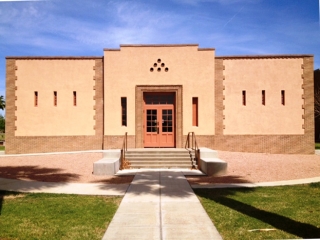celebrationNews & Events at NAC! Check out the latest from our organization.

Historical Indian School Band Building to be Renovated
Phoenix, AZ - The partners, Native American Connections (NAC) and the Phoenix Indian Center (PIC), have signed of a Letter of Understanding with the City of Phoenix to renovate the Band Building at the site of the former Phoenix Indian School, now Steele Indian School Park, located at Central Avenue and Indian School Road. The LOU was signed on the auspicious day of 11-12-13. The building has sat vacant since 1990 when the school closed.
"It's exciting that we can literally look across the street from our building and see the property," said NAC CEO Diana Yazzie Devine. The NAC/PIC Native American community service center is located at 4520 N. Central Ave. Continues Devine, "We are pleased to be working with the City of Phoenix to bring the band building back to life and create an environment where American Indians can meet and share their culture in a variety of ways."
The band building is approximately 6,000 sq. ft. and was built in 1931. By renovating the building, the partners hope to restore the spirit demonstrated in the building at the height of its use- a time when students came from several different tribal backgrounds, speaking different languages and used music as a way to communicate and play musical instruments in a band, operating as a team.
"The Phoenix Indian School was home to so many students from dozens of tribes for nearly 100 years," explains PIC CEO Patricia Hibbeler, "and it's that legacy we hope to honor by renovating the band building and making the space available to all people."
"The Band Building is key to preserving the legacy of the Phoenix Indian School," agrees James P. Burke, Director, Phoenix Parks and Recreation Department. "Its restoration and cultural programming will be a gift to Phoenix residents for generations to come."
Tentatively called, "The Phoenix Indian School Legacy Project," plans are for the band building to be a cultural gathering place where the community can learn about the history of Phoenix Indian School, hold meetings and seminars, experience Native Foods, sports events, arts, culture and music and at the same time, be connected to Tribal Tourism opportunities across the state and engage in entrepreneurial activities.
The firm of Architectural Resource Team (ART) has been hired to create the preliminary design for the interior of the building. Initial funding for the project comes from LISC Phoenix and Chase Bank. "LISC's contribution to this effort supports NAC's and PIC's outreach to the neighborhood as well as the larger Native American community. This project addresses not just the built environment by restoring an historic building, but includes programs that promote community, recreation and wellness," added LISC Executive Director Teresa Brice.
The partners plan to complete the renovations in time for events to be held on site when Super Bowl XLIX comes to Arizona on February 1, 2015.
# # # #
About NAC www.nativeconnections.org Founded in 1972, Native American Connections (NAC) has grown from a grassroots organization serving American Indian people with substance abuse issues to being recognized as a high quality provider of comprehensive behavioral health services and a full range of housing options for low-income families to chronically homeless individuals. NAC owns and operates 15 service-enriched sites that serve more than 10,000 individuals and families annually.
About PIC www.phxindcenter.org The Phoenix Indian Center is the first urban Indian Center in the Nation, providing services for 67 years and having served over 400,000 individuals and their family members. They are leaders in effective workforce development, youth leadership, drug and alcohol prevention, educational and language and cultural revitalization programs along with community engagement. The Center provides services in greater Phoenix and Prescott
Contact: Patty Talahongva
Community Development Manager
602-254-3247
p.talahongva@nativeconnections.org
(2-24-2014) "AZ Central Historical Phoenix Indian School Slide Show"
(2-24-2014) AZ Republic "Phoenix Indian School Band Building to Be Renovated"
Our traditions are the foundation of our organization - explore, learn, and utilize resources available for all.

Get the support you need with health, housing, and community services available at Native American Connections.

Your support changes lives and builds healthy communities. Find ways to get involved.

A "chronically homeless" individual is defined to mean a homeless individual with a disability who lives either in a place not meant for human habitation, a safe haven, or in an emergency shelter or in an institutional care facility if the individual has been living in the facility for fewer than ninety (90) days and had been living in a place not meant for human habitation, a safe haven or in an emergency shelter immediately before entering the institutional care facility. In order to meet the ‘‘chronically homeless’’ definition, the individual also must have been living as described above continuously for at least twelve (12) months or on at least four (4) separate occasions in the last three (3) years, where the combined occasions total a length of time of at least twelve (12) months. Each period separating the occasions must include at least seven (7) nights of living in a situation other than a place not meant for human habitation, in an emergency shelter or in a safe haven.
Federal nondiscrimination laws define a person with a disability to include any (1) individual with a physical or mental impairment that substantially limits one or more major life activities; (2) individual with a record of such impairment; or (3) individual who is regarded as having such an impairment. In general, a physical or mental impairment includes, but is not limited to, examples of conditions such as orthopedic, visual, speech and hearing impairments, cerebral palsy, autism, epilepsy, muscular dystrophy, multiple sclerosis, cancer, heart disease, diabetes, Human Immunodeficiency Virus (HIV), developmental disabilities, mental illness, drug addiction, and alcoholism.